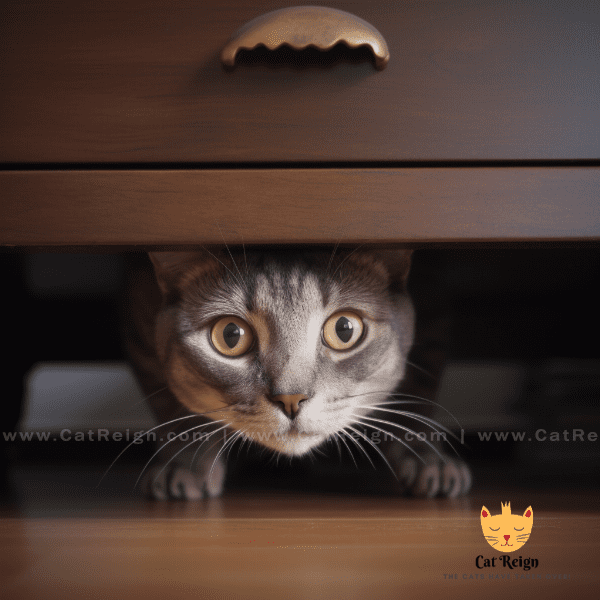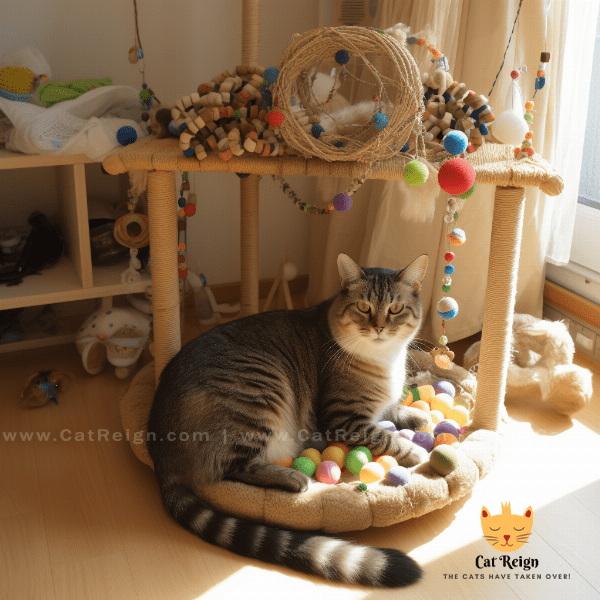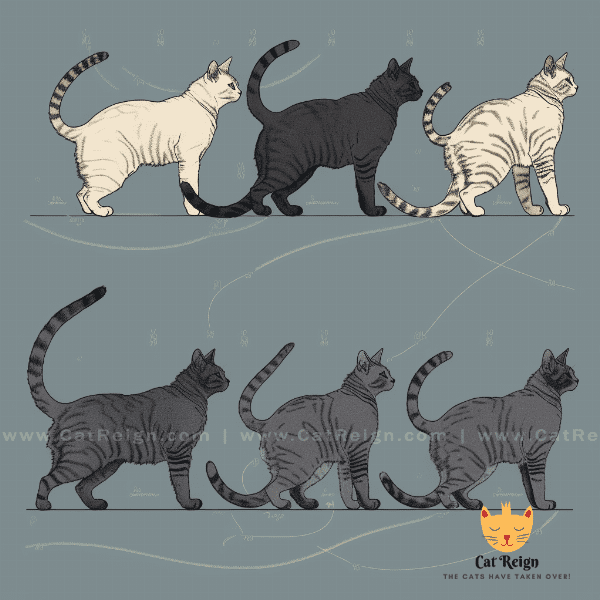Table of Contents
- Recognizing Fearful Body Language in Cats
- Common Triggers for Fear in Cats
- Creating a Safe and Comfortable Environment for Your Cat
- Understanding Your Cat’s Communication Style
- Techniques for Calming a Fearful Cat
- Building Trust with Your Cat through Positive Reinforcement
- Seeking Professional Help for Your Fearful Cat
- Preventing Fearful Behavior in Cats
- Tips for Helping Your Cat Overcome Fearful Situations
- Maintaining a Strong and Healthy Relationship with Your Cat
Recognizing Fearful Body Language in Cats
Cats are known for being independent and sometimes aloof creatures, but they can also be easily frightened. It’s important to be able to recognize the signs of fear in your cat so that you can address the cause and help them feel more comfortable and secure.
Dilated Pupils
One of the most obvious signs of fear in cats is dilated pupils. When a cat is afraid, their pupils will become larger and take up more of the eye. This is because the cat’s body is preparing to either fight or flee from the perceived threat. If you notice your cat’s pupils are dilated, it’s a sign that they are feeling scared or threatened.
Flattened Ears
Another common sign of fear in cats is flattened ears. When a cat is feeling scared or threatened, they will often flatten their ears against their head. This is a defensive posture that helps to protect their ears from any potential harm. If you notice your cat’s ears are flattened, it’s a sign that they are feeling frightened.
Tail Position
A cat’s tail position can also indicate their level of fear. When a cat is feeling scared or threatened, they will often tuck their tail tightly between their legs. This is a defensive posture that helps to protect their tail from any potential harm. Alternatively, if a cat is feeling threatened but still wants to maintain a sense of control, they may hold their tail stiffly and high.
Hiding Behavior
Cats are known for their ability to hide in small spaces, but if your cat is hiding more often than usual, it could be a sign that they are feeling fearful or anxious. Cats will often seek out small, enclosed spaces to hide in when they are feeling threatened. If you notice your cat hiding more often than usual, it’s important to investigate the cause and address it as soon as possible.
Vocalizations
Cats will often vocalize when they are feeling scared or threatened. This can include hissing, growling, or even screaming. If your cat is making more noise than usual, it could be a sign that they are feeling frightened.
By being able to recognize the signs of fear in your cat, you can address the cause and help them feel more comfortable and secure. Remember, cats are complex creatures with a variety of different body language cues, so it’s important to pay attention to your cat’s overall behavior and not rely on one cue alone.

Common Triggers for Fear in Cats
As a cat owner, it’s important to understand what can trigger fear in your pet. By identifying these triggers, you can take steps to avoid them and help your cat feel more secure and comfortable in their environment.
Loud Noises
Loud noises, such as thunderstorms or fireworks, can be extremely frightening for cats. The sudden loud noise can startle them and trigger a fear response. If you know that your cat is afraid of loud noises, it’s important to provide a safe and quiet space for them to retreat to during these events.
Strangers
Cats are naturally cautious animals and may become fearful around strangers. This is especially true if the stranger is unfamiliar to the cat or if the cat has had negative experiences with strangers in the past. If you have guests over, it’s important to allow your cat to approach them on their own terms and provide a safe space for them to retreat to if they feel overwhelmed.
Other Animals
Cats can also become fearful around other animals, especially if they are not used to being around them. If you have other pets in your home, it’s important to introduce them slowly and carefully to ensure that your cat feels safe and secure. Additionally, if you live in an area with a lot of wildlife, your cat may become frightened by the presence of these animals.
Changes in Routine
Cats are creatures of habit and may become anxious or fearful when their routine is disrupted. This can include changes in feeding schedules, changes in litter box placement, or changes in the layout of the home. If you need to make changes to your cat’s routine, it’s important to do so gradually and with plenty of positive reinforcement.
Medical Issues
Finally, it’s important to remember that fear in cats can also be a symptom of an underlying medical issue. If your cat is displaying fearful behavior that is not typical for them, it’s important to take them to the vet to rule out any underlying medical issues.
By understanding the common triggers for fear in cats, you can take steps to avoid these triggers and help your cat feel more comfortable and secure in their environment. Remember, every cat is different, so it’s important to pay attention to your cat’s behavior and adjust your approach accordingly.

Creating a Safe and Comfortable Environment for Your Cat
Creating a safe and comfortable environment is essential for helping your cat feel secure and reducing fear and anxiety. Here are some tips for creating an ideal environment for your cat.
Offer Plenty of Hiding Places
Cats feel most comfortable when they have plenty of hiding places available. This can include cat trees, shelves, or even a cardboard box. Having access to high spaces can also help your cat feel more secure.
Provide Plenty of Vertical Space
In addition to hiding places, cats also need access to vertical spaces. This can include cat trees, shelves, or even wall-mounted perches. Having access to high spaces can help your cat feel more in control of their environment.
Minimize Stressful Triggers
Finally, it’s important to minimize stressful triggers in your cat’s environment. This can include loud noises, changes in routine, or other animals in the home. By identifying and minimizing these triggers, you can help your cat feel more comfortable and relaxed.

Understanding Your Cat’s Communication Style
Understanding your cat’s communication style is crucial for building a strong and healthy relationship with your pet. Here are some key aspects of cat communication to look out for.
Body Language
Cats communicate primarily through body language. Understanding your cat’s body language can help you identify when they are feeling scared, happy, or playful. As we discussed earlier, dilated pupils, flattened ears, and tail position can all indicate your cat’s emotional state.
Vocalizations
In addition to body language, cats also communicate through vocalizations. Hissing, growling, and meowing are all common vocalizations that cats use to communicate. Pay attention to the tone and pitch of your cat’s meows, as this can give you clues about their mood.
Scent Marking
Cats also communicate through scent marking. They use scent glands located on their cheeks, paws, and tail to mark their territory and communicate with other cats. If your cat rubs their head against you, it’s a sign of affection and a way for them to mark you as their own.
Play Behavior
Play behavior is another way that cats communicate. When cats play, they are often acting out hunting behaviors and practicing their skills. Play behavior can also be a sign that your cat is feeling happy and relaxed.
Eye Contact
Finally, eye contact is another important aspect of cat communication. Direct eye contact can be seen as a sign of aggression or dominance, so if your cat is staring you down, it’s best to avoid making eye contact back.

Techniques for Calming a Fearful Cat
Calming a fearful cat can be a challenging task, but with patience and persistence, you can help your pet feel more comfortable and relaxed. Here are some techniques for calming a fearful cat.
Offer Treats and Toys
Offering treats and toys can also help your cat feel more comfortable and relaxed. Interactive toys, such as puzzle feeders, can help stimulate your cat’s mind and distract them from their fears.
.

Building Trust with Your Cat through Positive Reinforcement
Building trust with your cat is essential for creating a strong and healthy relationship. Positive reinforcement is a powerful tool for building trust and encouraging good behavior. Here are some tips for building trust with your cat through positive reinforcement.
Start with Basic Training
Training your cat is a great way to build trust and establish a positive relationship. Start with basic commands, such as “sit” or “come,” and use positive reinforcement to reward good behavior. Treats, toys, and verbal praise are all effective rewards.
Use Treats and Toys
Treats and toys are great tools for building trust with your cat. Offering treats and toys during training sessions can help create a positive association with training and encourage good behavior.
Be Consistent
Consistency is key when it comes to building trust with your cat. Make sure to use the same commands and rewards consistently, and avoid using punishment or negative reinforcement. This will help your cat feel secure and reduce anxiety.
Respect Your Cat’s Boundaries
It’s important to respect your cat’s boundaries when building trust. If your cat is feeling anxious or scared, give them space and avoid forcing them into situations that make them uncomfortable.
Spend Quality Time Together
Spending quality time together is another important aspect of building trust with your cat. This can include grooming, playing, or simply spending time in the same room. The more time you spend with your cat, the more comfortable they will become around you.
Use Positive Body Language
Finally, using positive body language can help build trust with your cat. Avoid making direct eye contact, which can be seen as a sign of aggression, and use gentle movements and a calm tone of voice.

Seeking Professional Help for Your Fearful Cat
If your cat’s fear and anxiety are severe or persistent, it may be necessary to seek professional help. Here are some options for seeking professional help for your fearful cat.
Veterinary Consultation
If you suspect that your cat’s fear is related to a medical issue, it’s important to schedule a veterinary consultation. Your vet can perform a physical exam and run any necessary tests to rule out any underlying medical issues that may be contributing to your cat’s fear.
Animal Behaviorist
If your cat’s fear is not related to a medical issue, a certified animal behaviorist can provide guidance and support. Behaviorists are trained to evaluate your cat’s behavior and develop a customized plan to address their fears.
Medications
In some cases, medications may be necessary to help manage your cat’s fear and anxiety. Your vet or a certified animal behaviorist can prescribe medications to help reduce anxiety and improve your cat’s quality of life.
Training and Desensitization
Training and desensitization techniques can also be effective in reducing your cat’s fear and anxiety. A certified animal behaviorist can develop a training plan to gradually expose your cat to the things that they are afraid of, helping them become more comfortable and relaxed.
By seeking professional help for your fearful cat, you can ensure that they receive the care and support they need to overcome their fears and anxieties. Remember, every cat is unique, so it’s important to work with a professional to develop a customized plan that meets your cat’s individual needs.

Preventing Fearful Behavior in Cats
Preventing fearful behavior in cats is key to ensuring a happy and healthy pet. Here are some tips for preventing fearful behavior in your cat.
Socialization
Socialization is crucial for preventing fearful behavior in cats. Socializing your cat at a young age can help them become more comfortable and confident around other animals and people. This includes exposing them to different people, animals, and environments.
Consistent Routine
As we mentioned earlier, cats thrive on routine. Keeping a consistent routine can help reduce anxiety and prevent fearful behavior. This includes feeding schedules, playtime, and other daily activities.
Calming Aids
Calming aids, such as pheromone sprays or supplements, can also help prevent fearful behavior in cats. These products mimic the natural pheromones produced by mother cats and can help your cat feel more calm and relaxed.
Proper Training
Proper training is also essential for preventing fearful behavior in cats. Training your cat to obey basic commands and to be comfortable with handling can help reduce anxiety and prevent fearful behavior.

Tips for Helping Your Cat Overcome Fearful Situations
Helping your cat overcome fearful situations can be a challenging task, but with patience and persistence, it is possible. Here are some tips for helping your cat overcome fearful situations.
Stay Calm
It’s important to stay calm and composed when your cat is exhibiting fearful behavior. Cats can pick up on your emotions, so if you are anxious or stressed, your cat is likely to be as well.
Provide a Safe Space
Providing a safe space for your cat is essential for helping them overcome fearful situations. This can be a small, enclosed space like a cat bed or a cardboard box. Make sure the space is comfortable and contains some of your cat’s favorite toys or blankets.
Gradual Exposure
Gradual exposure to the things that your cat is afraid of can help them become more comfortable and relaxed. Start with short periods of exposure and gradually increase the length of time as your cat becomes more comfortable.
Use Positive Reinforcement
Positive reinforcement is an effective way to encourage good behavior and help your cat overcome fearful situations. Treats, toys, and verbal praise are all effective rewards.
Seek Professional Help
If your cat’s fear is severe or persistent, it may be necessary to seek professional help. Your veterinarian or a certified animal behaviorist can provide additional guidance and support.
Avoid Punishment
Punishing your cat for exhibiting fearful behavior is not an effective way to help them overcome their fears. Instead, focus on using positive reinforcement and gradual exposure to help your cat become more comfortable and confident.
By following these tips for helping your cat overcome fearful situations, you can help them become more comfortable and confident in their environment. Remember, every cat is unique, so it’s important to be patient and adjust your approach based on your cat’s individual needs.

Maintaining a Strong and Healthy Relationship with Your Cat
Maintaining a strong and healthy relationship with your cat is important for their physical and emotional well-being. Here are some tips for maintaining a strong and healthy relationship with your cat.
Regular Check-Ups
Regular check-ups with your veterinarian are important for maintaining your cat’s health. This includes vaccinations, dental cleanings, and other preventative care measures.
Proper Nutrition
Proper nutrition is essential for maintaining your cat’s health. Make sure to feed your cat a well-balanced diet that is appropriate for their age and activity level.
Exercise and Playtime
Exercise and playtime are important for keeping your cat physically and mentally healthy. Make sure to provide your cat with toys and opportunities for play and exercise.
Positive Reinforcement
Using positive reinforcement is an effective way to maintain a strong and healthy relationship with your cat. Reward good behavior with treats, toys, or verbal praise, and avoid punishment or negative reinforcement.
Quality Time
Spending quality time with your cat is important for maintaining a strong and healthy relationship. This includes grooming, playing, and simply spending time in the same room.
Environmental Enrichment
Environmental enrichment is another important aspect of maintaining a strong and healthy relationship with your cat. Providing your cat with toys, scratching posts, and other forms of environmental enrichment can help stimulate their minds and prevent boredom.
By following these tips for maintaining a strong and healthy relationship with your cat, you can help ensure a happy and healthy pet. Remember, every cat is unique, so it’s important to pay attention to your cat’s individual needs and adjust your approach accordingly.




